If you’ve never gotten a flat bike tire, you’re among a very small percentage of riders. While flats don’t happen all the time, they certainly do occur…and always at the most inconvenient time.
There are many factors that influence how often you can expect to get a flat tire. Let’s break it down in this comprehensive guide on everything you ever wanted to know about flat tires!
How Often Bikes Get Flat Tires (A General Rule)
In general, you’ll probably deal with at least one flat tire during the riding season. But this number can increase based on the type of bike you have and style of riding you do, whether or not you race, the terrain you ride, how often you ride, and even the intended purpose of the tires you buy.
We’ll cover each of these factors in more detail throughout this guide, but before we do, let’s define what “flat tire” means in this article. In the following sections, a flat tire refers to one that has been punctured or suffers some type of damage that leads to air loss, whether rapid or slow.
Air pressure loss can also occur naturally over time without the tire suffering any external damage. While annoying, this is a completely normal phenomenon. We’ll address this as well later on, but for the purposes of this article, it will be covered separately.
How Often Mountain Bikes Get Flat Tires
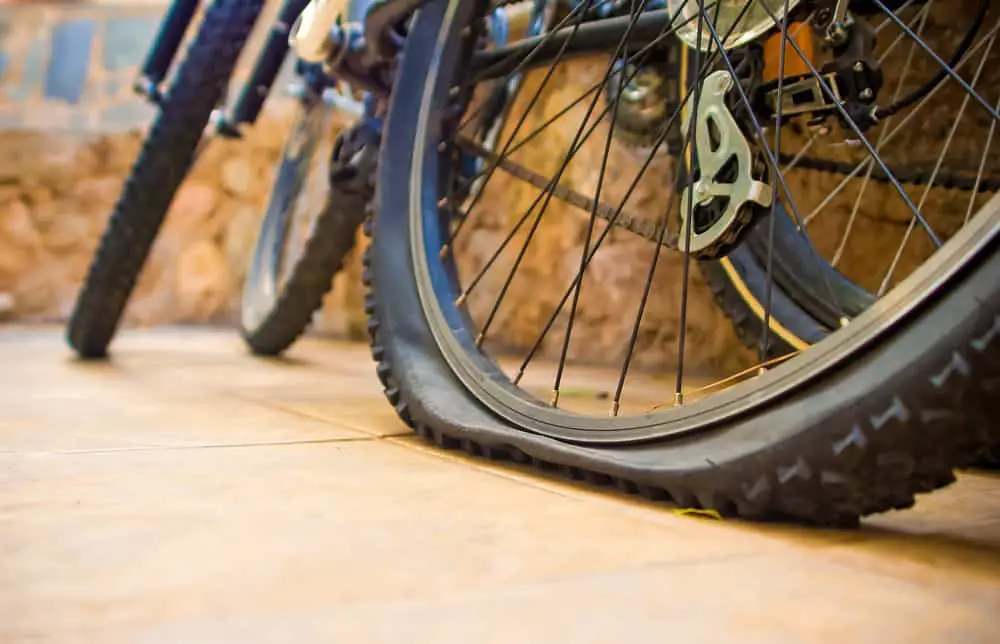
Mountain bikes tend to get flat tires more often than road or hybrid bikes. This is due in large part to the rough terrain common to most mountain biking trails. Riding over roots, rocks and other obstacles can wreak havoc on your tires.
If you’re a cross-country (XC) or moderate trail rider, one flat per season is probably normal (though this will increase the more miles you put in, and especially if you race, which tends to be harder on your bike).
For more hardcore trail riders, enduro or downhill/bike park riders, one flat per season would be a miracle. Tackling rougher trails at higher speeds takes a serious toll on your tires. Even tires built specifically for these riding disciplines probably won’t last multiple seasons if you really like to push your bike to the limits.
Terrain also plays a major role here. If extremely rocky areas like in Moab, Utah are your home trails, you’ll be replacing tires more frequently than someone riding in the soft loam of the Pacific Northwest.
How Often Road Bikes Get Flat Tires
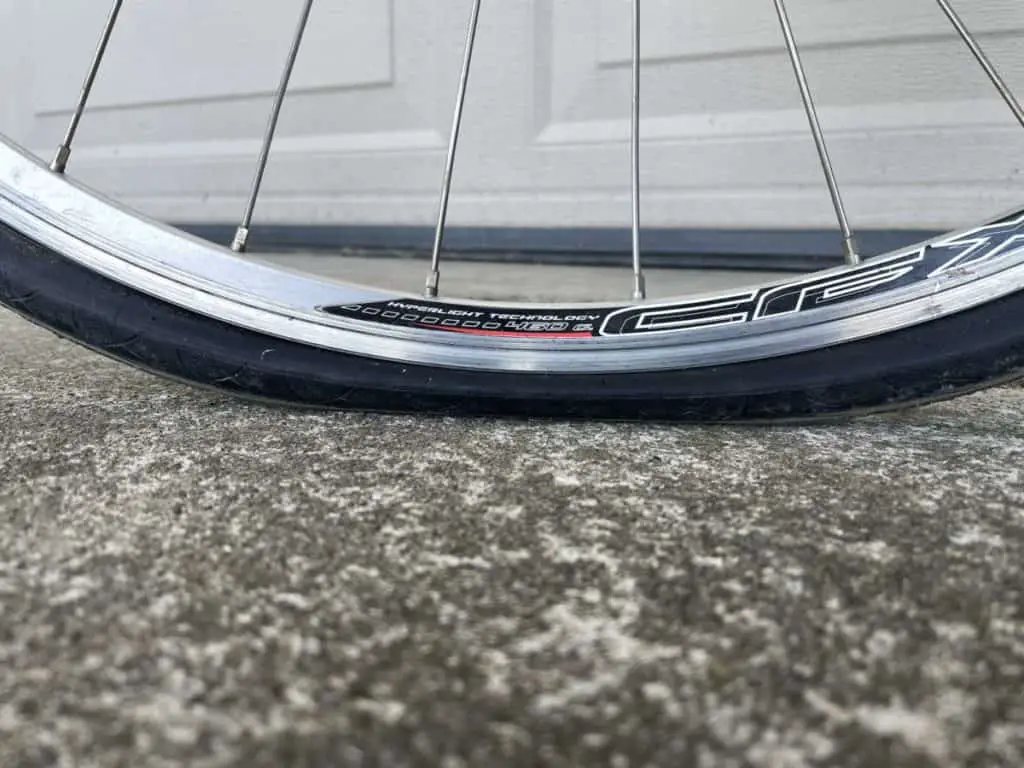
Since road bikers love to measure the miles they put in, let’s take the same approach for tire longevity.
According to an article published by Bicycle Warehouse, you can expect good road bike tires to last 1,000-3,000 miles. Spend a little more money on higher quality tires however, and you should be getting closer to the high end of that range.
But more money isn’t always the secret to tire longevity. For instance, high performance racing tires can be very expensive, but have a drastically shorter lifespan. Racing performance and durability are often mutually exclusive: what makes a tire fast and light does not make it durable, and vice versa. You’d be lucky to get 1,000 miles out of a tire designed for racing.
While mountain bike tires tend to rupture more often than road tires given the rough terrain they’re meant to handle, there is one factor that makes road tires more vulnerable to damage…and it has to do with air pressure.
Mountain bike (and hybrid) tires are referred to as high-volume, meaning they hold a greater quantity of air. Road bike tires are referred to as high-pressure, meaning while they hold less air overall, that air is exerting way more pressure per square inch (psi) inside the tire.
While the average mountain bike tire may be inflated to 20-30 psi (possibly less if the tire is tubeless), the average road tire will be inflated to 90-120 psi! With up to 4x the air pressure in a narrower, thinner container, road bike tires are at greater risk of puncturing if they do roll over something sharp.
How Often Other Bikes Get Flat Tires
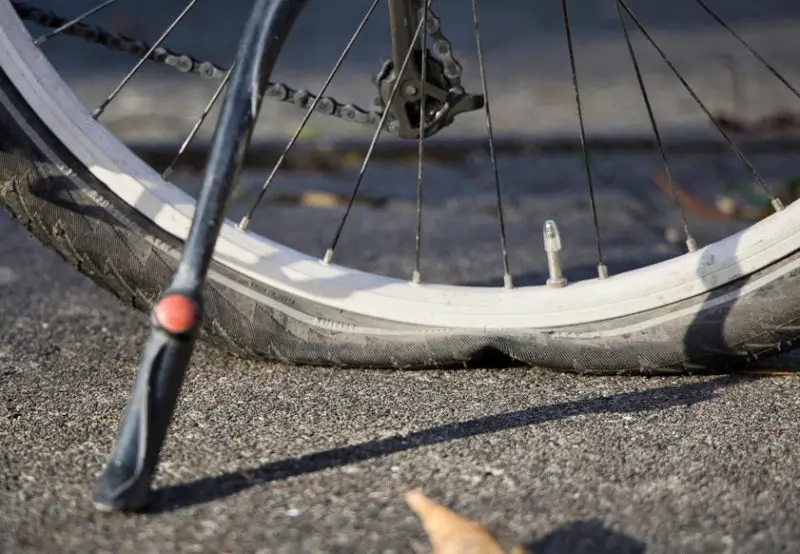
Hybrids, BMX or commuter bike tires will typically last as long as average road bike tires, but can last much longer. There are several reasons for this.
First, these types of bikes will not (or should not) be ridden on as rough terrain as compared to mountain bikes. They will also not typically be ridden for as many miles per ride as road bikes. These factors will significantly increase the lifespan of the tires.
Second, they have tires that are designed with durability top of mind. Commuter bikes need to hold up to daily use in city environments, and BMX bikes need to be able to absorb frequent hard landings. Their tires will reflect these needs.
Mountain bike tires are designed for maximum traction, and road bike tires are designed for speed and lightness. These requirements create tires that are very soft, grippy and lightweight, but they sacrifice durability.
Hybrid bike tires don’t need to be as grippy or lightweight for their intended purpose, so they can be made with more durable rubber compounds.
Of course, if you commute or ride BMX on streets that aren’t in the best of shape, this can significantly reduce the lifespan of your tires. Obstacles like loose pieces of asphalt, potholes, nails, broken glass or any other sharp object you can think of can shred even the toughest of tires.
Why Your Bike Keeps Getting Flat Tires (Frequently)

Flat tires are just a part of riding bikes. But do you feel you’re getting flats way more often than you should? One (or more) of these factors may apply to you:
3 Causes of Frequent Flat Bike Tires
1. Tire Compound
Most tire brands offer models with different rubber compounds: some less expensive compounds are harder and don’t offer as much traction, while more expensive compounds are softer and stick to the ground like Velcro.
These softer compounds are great for added grip on gnarly trails or to help you go faster on the road, but their one drawback is reduced longevity. Softer tires break down faster and will be more prone to punctures. If you need maximum grip or want the best performance on the road, you’ll have to be willing to buy new tires more frequently.
If you’re a more casual rider, you really don’t need to upgrade to tires with the softest compound. It will also help reduce your annual replacement tire expenditure!
2. Tire Sidewall
Even more overlooked is your tire’s sidewall. Most tire models come in a variety of sidewall options. Different sidewalls are appropriate for different terrain, but also different rider weights.
Let’s use Maxxis, one of the most popular tire brands in the world, as an example. Maxxis offers road and mountain bike tires in different sidewall options. The lightest sidewalls help save weight, but are more prone to punctures. Heavier sidewalls can add quite a bit of weight to your wheels, but they’re great for aggressive riding or for riders who are on the heavier side.
The video below explains the difference between these sidewall options in greater detail:
If you’re running tires with light sidewalls to save weight, but you’re on the heavier side or ride really rough terrain, there’s a good chance you’ll be experiencing more flats. You’d be better off switching to tires with a more durable sidewall to accommodate your weight and riding style. The extra tire weight is well worth the increased durability.
3. Tire Pressure
Tire pressure is a very individual thing. Riders have to take into account their weight, the terrain they ride, as well as whether or not they run tubeless tires. If you get a lot of flats, there’s a good chance you’re under or overinflating your tires based on those criteria.
I recommend setting your tire pressure according to your weight first, and then adjusting based on the terrain you ride and whether or not your tires are tubeless. There are many online tire pressure calculators, but I’d suggest reading through the following:
This will get you pointed in the right direction. Once you have your tire pressure set, take the following guidelines into account to get it dialed perfectly:
- Your rear tire should be slightly higher pressure (2-4 psi) than your front tire
- Tubeless tires can run slightly lower tire pressure (5-8 psi less) than tires with tubes
- Tires with heavier sidewalls can run lower pressure than tires with thinner sidewalls
- If you ride rough terrain or trails with lots of rocks, increase your tire pressure (2-5 psi)
- Wider tires can run lower pressure than narrower tires
It will take some trial and error to figure out which tire pressure feels best, and it will constantly change depending on where and how you ride, but being conscious of these factors will help you set your tire pressure up best for the circumstances and reduce the number of flats you’re getting.
How Quickly Do Bike Tires Deflate?
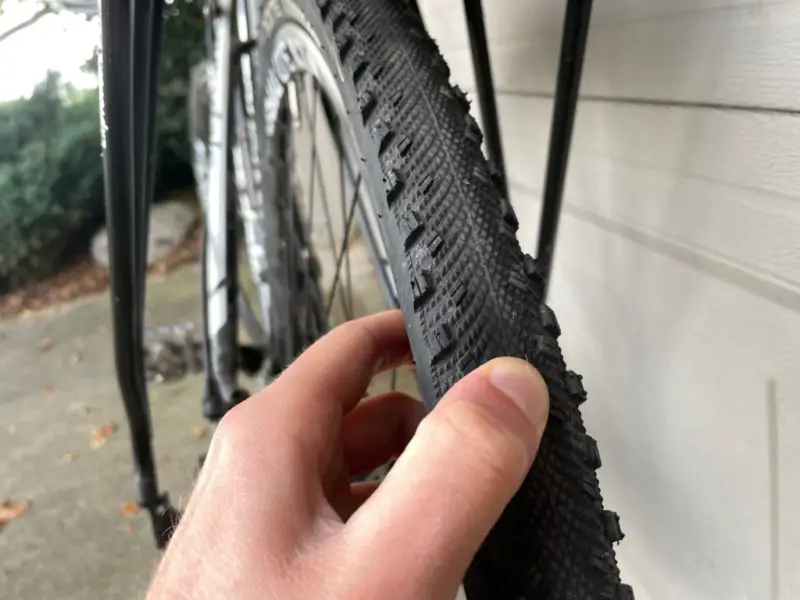
Bike tires will lose air naturally over time, even without being punctured. Noticeable pressure loss can occur in less than a week…even in as little as 1-2 days depending on the type of tires you have. This is why it’s important to check your tire pressure before every ride.
While the type of tire matters a great deal, whether or not you use tubeless tires also has a significant impact on how quickly you’ll experience pressure loss.
Tubeless tires tend to lose air pressure slower: since they can be run at lower air pressures than tires with tubes, there is less pressure being exerted inside the tire (and on the valve specifically) so it’s less prone to leaking.
Let’s take a look at the different categories of tire below and how they compare:
How Quickly Mountain Bike Tires Deflate
Mountain bike tires are a lot thicker, wider and more robust than road or hybrid bike tires. As such, they tend to hold air better. You can probably go at least a week in good conditions without a noticeable loss in air pressure.
A noticeable loss doesn’t mean your tires need to be completely flat: just that they’ve dropped enough pressure (5-10 psi will do it) to feel a little squishy.
However, there are some circumstances that will speed up pressure loss. If you frequently ride on rough, rocky terrain, all those square-edged hits your tires soak up can burp some of the air out of them.
Additionally, if you store your bike in very hot or cold temperatures, this can also lead to pressure loss. Air condenses in cold temperatures, so your tires may start to feel soft after prolonged exposure to cold weather. Air expands in hot temperatures, which can cause it to leak out of the tire valve or around the tire bead.
The takeaway? Temperature extremes are no friend to your tires! Storing your bike in a cool dry place is ideal if you want to avoid pressure loss and keep your bike in great shape.
How Quickly Road Bike Tires Deflate
Road bike tires are designed to be much lighter and thinner than mountain bike tires. However, this weight savings and low-profile design comes at a cost: road bike tires will not hold air as well. Very light, race-oriented tires may see noticeable pressure loss in only a few days.
But this thin design isn’t the only reason for such rapid pressure loss. As I mentioned earlier, road bike tires are also inflated to pressures roughly 3-4x that of mountain bike tires! This exerts a tremendous amount of internal pressure on these tires, causing them to leak through the valve or bead much more easily.
Since road bike tires are inflated to such high pressures, it will take more pressure loss for you to feel a noticeable difference. But this is why they should be checked more frequently; a 5-10 psi reduction may not be a lot for a 120 psi tire, but it will increase rolling resistance and reduce pedaling efficiency…neither of which you want during a long ride or a race!
How Quickly Other Bike Tires Deflate
Hybrid bike tires are generally designed to do a little bit of everything (obvious from the name, right?) They’re light enough to be efficient commuters, but have enough traction to do well on moderate off-road adventures. They’re also made to be extra durable to handle a wide variety of terrain.
Because of this, hybrid bike tires tend to hold air at least as long as mountain bike tires, but usually longer. You could go a couple weeks without pressure loss significant enough to affect your bike’s performance.
This holds true for BMX bikes as well. Since these tires are designed to be thick and robust enough to handle hard landings with no suspension, they hold air very well.
But just as with road and mountain bikes, you should still get in the habit of checking tire pressure frequently: proper tire pressure will make your bike feel and handle a lot better.
Can Bike Tires Go Flat Just From Sitting Unused?
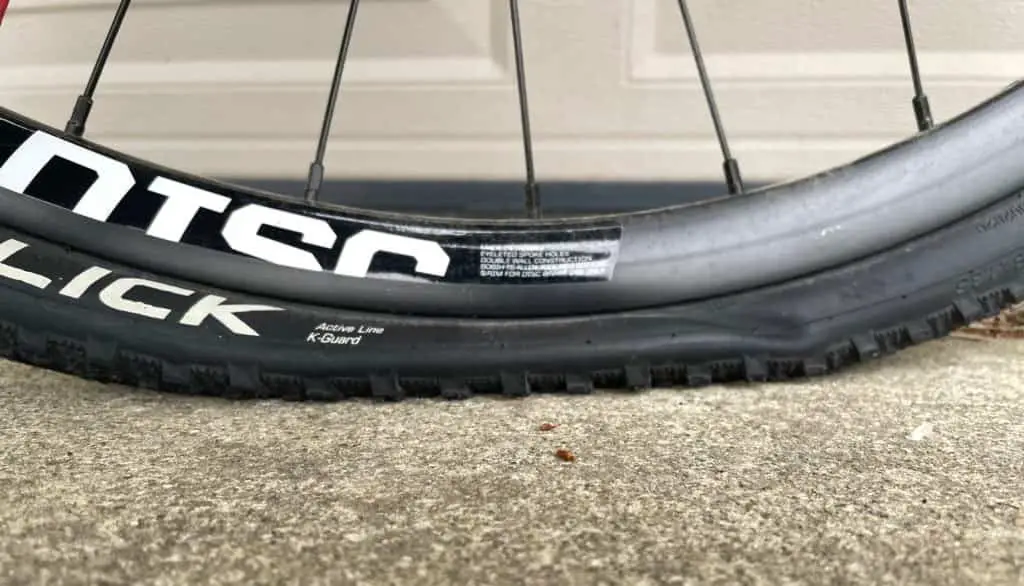
When you pull your bike out of storage for the start of another riding season, you may notice your tires have gone completely flat, even though you haven’t used your bike in months.
So why does this happen?
There are quite a few culprits responsible for this issue:
Porosity of Rubber Tires and Tubes
Though it may not seem like it, rubber is actually quite porous: over time, air will escape through these microscopic holes. This is completely normal, though it will take a long time for tires to go flat due to this reason alone. That’s why you only notice it when you haven’t ridden your bike for months.
Undetected Tire or Tube Damage
It’s pretty easy to tell when your tire or tube sustains a puncture, but it’s much harder to notice when microtears are causing air to leak from your tire. Because the air escapes so slowly, it may often take weeks or months for the tire to go completely flat.
So while your tires may have appeared to be in great condition when you put your bike in storage, they may not look that way when it’s time to ride again!
Dry Rot
Even unused tires have a shelf-life. Any material will begin to break down over time, and rubber is no exception. It may take years for rubber to lose its elasticity, but it will eventually happen. Tire and tubes will become brittle and unusable.
This occurs even if tires are stored in perfect conditions, but the process will be sped up if they’re exposed to excessive humidity or moisture. Mold and mildew will break down your tires much more rapidly, so keep them dry for increased longevity!
Excessive Cold
As I mentioned earlier, cold temperatures cause the air in your tires to condense and take up less space. If you store your bike in a very cold place, your tires may appear deflated when you take it out.
This does not mean that your tires are damaged in any way; just inflate them back to the proper pressure and you’ll be good to start another riding season.
For a deeper dive into this subject, check out our previous article, Can Bike Tires Go Flat Just From Sitting Unused?
How Often Should You Pump Your Bike Tires?
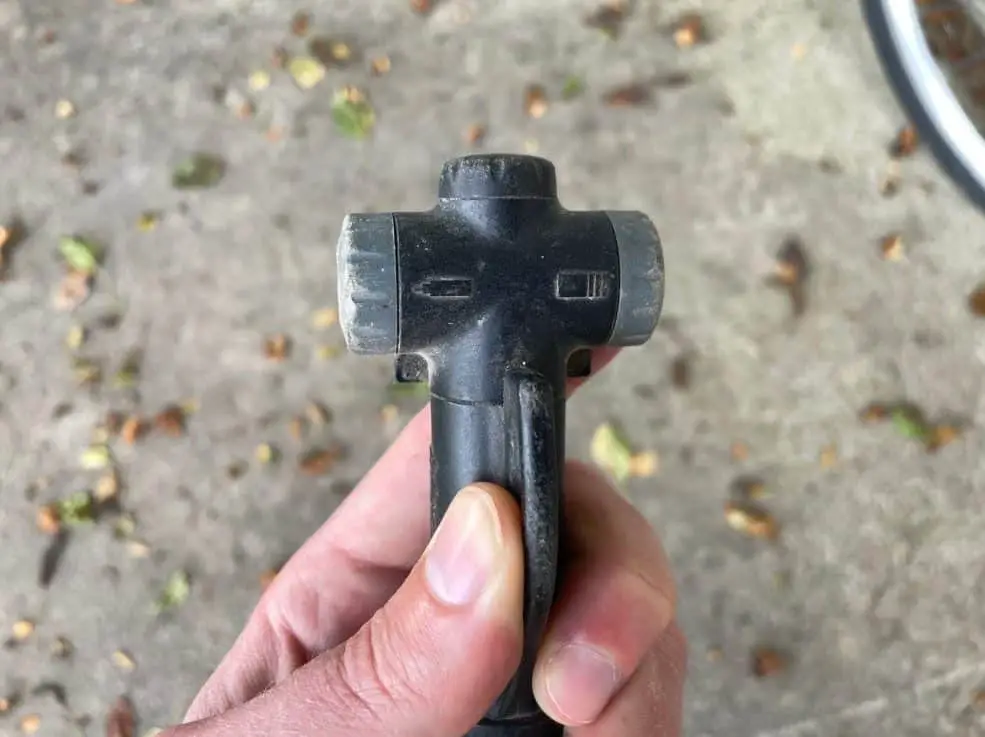
If you followed the tire pressure guidelines in the articles linked earlier, you should have gotten your tire pressure dialed in for your weight and the type of riding you do.
So how often should you pump your bike tires to make sure they stay at the optimal pressure?
It’s simple: whenever they get low!
Even most budget tire pumps have a tire pressure gauge on them. And since you should be checking your tire pressure at least every few rides, this is the perfect time to add more air if needed. A loss of a few psi might not sound like much, but it will have a negative impact on how your bike handles and performs.
Want to know more about tire pressure and how to find the right pressure for you? Read through our previous article, How Often Should You Pump Bike Tires?
